If summer reading is all about engaging reads, then I am nailing it with this collection of books. SO much good stuff to share with you today. Let’s jump right into the reviews!
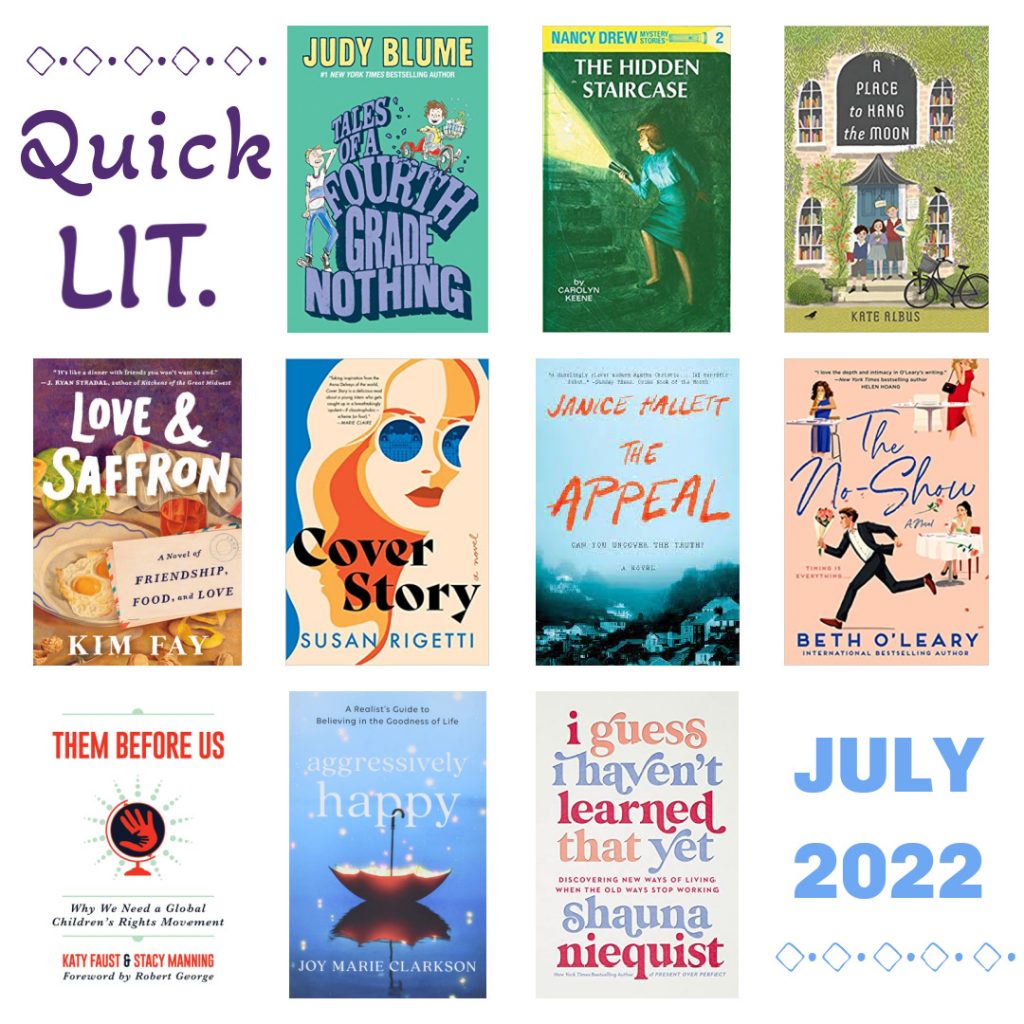
NONFICTION
Aggressively Happy: A Realist’s Guide to Believing in the Goodness of Life, by Joy Marie Clarkson: You don’t need me to tell you that life is hard. And scary. And often depressing. Fear, anger, and sadness are the most obvious responses to these crazy times. But it doesn’t have to be that way; WE don’t have to feel that way. In this uplifting (but not at all oblivious) book, Joy Marie Clarkson (daughter to well-know author Sally Clarkson) invites us to take a different approach in choosing to be happy. She writes, “If we accept that life will be full of difficulties and sorrows, we then have two options: to resign ourselves to life generally being a bummer, or to seek enjoyment, delight, and hope in the midst of (and in spite of!) life’s up and downs. To put it bluntly: You could choose to cultivate happiness, or you could not. . . . I think we should go for it.”
Happiness hasn’t always come easily to Joy. Like many of us, she has faced hardship and despair, grappled with anxiety and depression, and even lived through a global pandemic (we might know a thing or two about that ourselves). But following an especially dark period, Joy made a choice: she was going to live, happily. She adopted as a personal mantra a term once used as a criticism of her, “aggressively happy.” Joy recognized that choosing to live happily made for a much more pleasant life for herself and those around her, and she knew that embracing happiness would mean living out a story of truth that points to the reality of a good world overflowing with reasons for joy.
This book is not your typical how-to guide, nor is it entirely made up of personal essays or commentaries. Instead, it blends elements of various genres, from storytelling to societal and theological commentary. Building upon a rich understanding of history, literature, and Scripture, Joy offers several proven paths to happiness, from befriending sadness (this brought Susan Cain’s Bittersweet to mind and I loved how it infused Jesus into this subject in a way Cain’s work did not) and learning to flounder well, to tending to one’s physical needs, shifting our internal narratives and eternal perspectives, finding genuine fulfillment through faith, and embracing our identity as God’s created, dearly loved children. In my favorite chapter, Joy encourage us to enjoy things unironically—liking what we like, without apology or pretense. Each chapter ends with suggestions for further exploration, including artwork to ponder, books to read, and music to enjoy.
I’ve read a number of books on this subject but appreciated Joy’s fresh take that is optimistic but not naively so, merging practical with theoretical and dousing it all in whimsical language and cozy stories. At points within the book, the author’s youth becomes obvious, with writing that is a tad too earnest, prose that is slightly pretentious, and a tone and ideas that feel more Victorian than twenty-first century. Joy is a darling narrator, though: enthusiastic, hopeful, unapologetically quirky, and wise beyond her years.
I will say that I wasn’t a fan of the audiobook. The content is well-suited to audio format, but the audio is not read by the author, and the narrator’s tone grated on me. I suspect this would have been a 5-star read if I wasn’t so distracted by the unfortunate narration, and I hope to give this book a reread in another format in the future. It would an excellent nightstand book to be enjoyed a chapter at a time, whenever a need for some happiness might arise.
My Rating: 4.5 Stars (Rounded up to 5 Stars on Goodreads) // Book Format: Audiobook
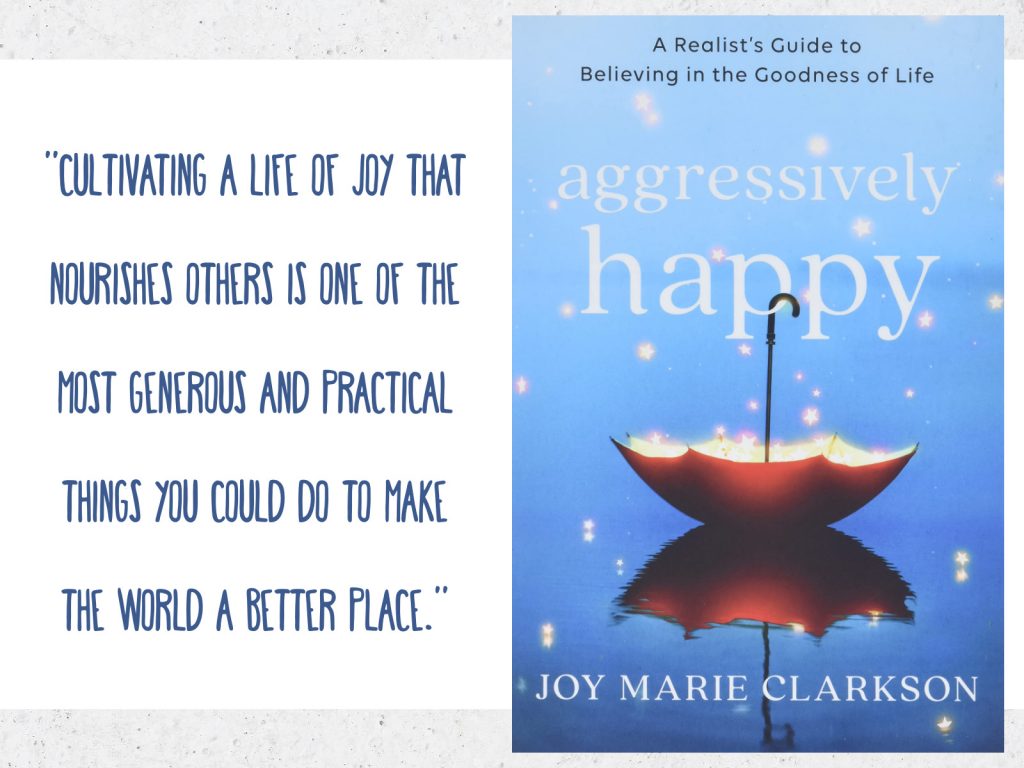
Them Before Us: Why We Need a Global Children’s Rights Movement, by Katy Faust and Stacy Manning: We have reached a strange spot in our society, where children are both idolized and undervalued. Couples go to great lengths to exercise their “right” to biological parenthood, resorting to reproductive technologies such as surrogacy and egg and sperm donors. Meanwhile, these same children’s genuine rights to grow up knowing their biological parents—and to be raised by both their mother and father, who are married to one another—are considered optional. In Them Before Us, children’s rights advocates Katy Faust and Stacy Manning flip the script on the adult-centric attitudes to marriage, parenthood, and fertility to expose the ways that prioritizing adult desires can compromise the emotional and physical well-being of children.
Through testimonies from the “victims” (offspring of homosexual, transgender, and divorced parents, and children conceived through IVF and/or carried by surrogates), the authors share the not-so-glamorous aspects of some of the prevalent ideologies and commonly accepted practices related to the modern family. The book sorts out fact from fiction within studies claiming only positive outcomes for children raised in unconventional family settings, and it draws attention to the lack of child advocates and abundance of adult selfishness in our current age.
This book will ruffle a lot of feathers: it tackles all of the hottest issues of the day, and does not hold back on pointing out where we really are getting it wrong in our assumptions that “the kids will be fine.” I lean pretty heavily conservative with all things marriage and family, but even I had some of my assumptions challenged, especially regarding the issues that felt a little more personal to me (such as divorce and IVF, as I have friends and family members navigating these waters). Still, I was glad to have my eyes opened to the harm being done to children in these areas.
This is largely an “awareness” book, and I wish the authors had more helpful solutions to offer beyond simply informing readers of these problems. I also wish it were more empowering of the children who have already been affected by divorce, same-sex parents, IVF, etc. (It portrays these children as the victims they are, but does nothing to encourage them to move through the pain they have endured.) And while the book does not necessarily set out to villainize adults who have not prioritized their children’s rights, I believe the authors could have taken a more compassionate and nuanced stance in their views.
As difficult as this book is, I am appreciative of the Them Before Us Movement and its willingness to shine light on the ugly realities of an adult-centric focus on marriage and family. I know I will be taking these issues more seriously in the future.
My Rating: 4 Stars // Book Format: Audiobook
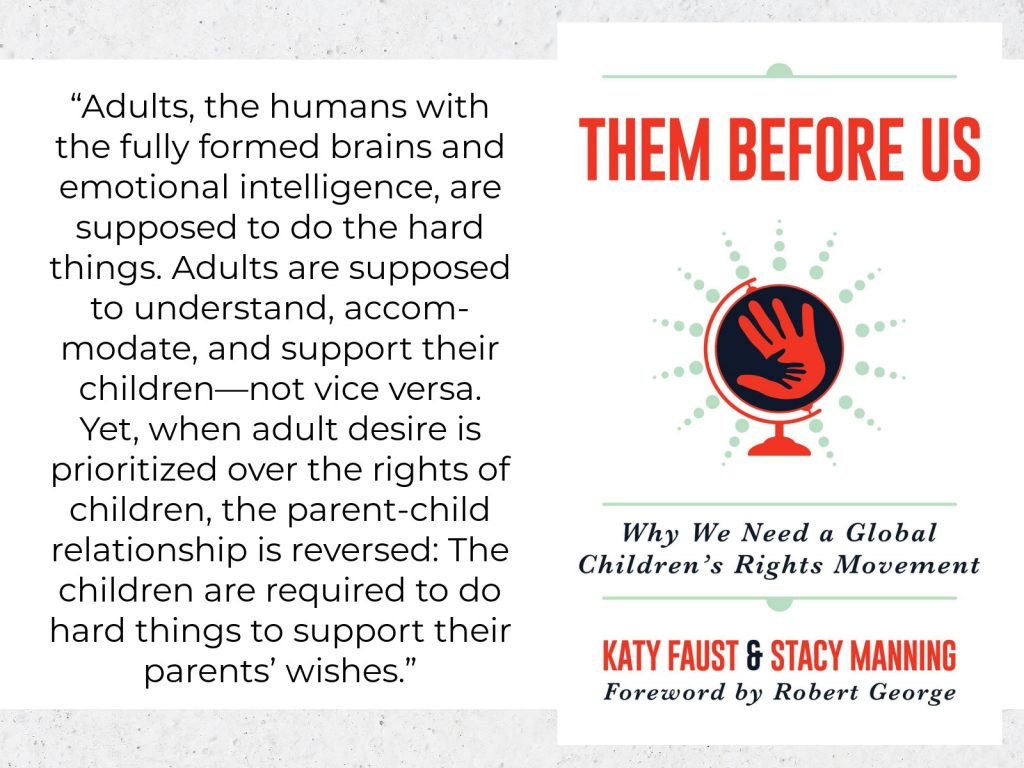
I Guess I Haven’t Learned That Yet: Discovering New Ways of Living When the Old Ways Stop Working, by Shauna Niequist: Just after her fortieth birthday, Shauna Niequist’s life fell apart in some pretty big ways—from public and physical, to personal and spiritual. The Niequists responded to the breakage by leaving their friends, family, and church in the suburbs of Chicago and relocating to a tiny NYC apartment on the campus of an Anglican seminary. There, Shauna, Aaron, and their two sons relearned everything about who they are as a family, what they believe, and how to “do life” in an entirely different way. Some things came easily, but much didn’t, and the family mantra become one of humble acknowledgement and also hope: I guess we haven’t learned that YET. In this collection of 49 essays, Shauna brings us along for the exploration of those things she has learned and those she hasn’t quite learned yet.
They say that books are either a window or a mirror. For me, this was both: it was a mirror of so much of my personal journey—a transformative move across country, mental health struggles, body image woes, maturing faith, a transformation of identity and perception, and a grappling with one’s beliefs (sorting through what to keep and what to release, and figuring out who we are when the dust has settled). And it was a window into other experiences I’ve never known—life in New York City, weathering a devastating public scandal, and a near-loss of faith. In some ways, this book served as a doorway—helping prepare for my own entry into menopause and mid-life questioning and shifts in parenting and marriage roles. Parts of the book could have been lifted from my own journal; others were things I hope never to enter into my journal, or one day will (and then will be thankful to have had a buddy leading the way).
Shauna is from the midwest, and her writing encapsulates everything we love about that part of the country: it is straightforward, neither too flowery or pretentious, and doesn’t shy away from the truth. It is also compassionate, curious, rooted, and humble, exuding the hospitable spirit for which Shauna Neiquist is well known. This is a book for the senses, with its mouthwatering food descriptions and strong sense of place: Shauna is enamored with the world and with the city, and she welcomes us into her own sense of wonder, even in the midst of deep pain and struggle and questioning.
Having weathered a global pandemic and reentering a world that feels a little unfamiliar and a little rough, there are many things we ALL are learning and relearning. Shauna’s take on this experience is refreshing and hopeful, reminding us that we will not get through this life unscathed, but that survival and even thriving are possible.
As someone who is pursuing wholehearted living this year (and into the future, of course) I recognize Shauna Niequist as another wholehearted pursuer. She writes, “the healthiest, most wholehearted people I know are the ones who have suffered, who have lost, who have wrestled, who have pushed back up to the surface.” Shauna is one of these sufferers, and I admire her candor and courage as she breaks the surface and invites us to do the same.
My Rating: 5 Stars // Book Format: Nonfiction
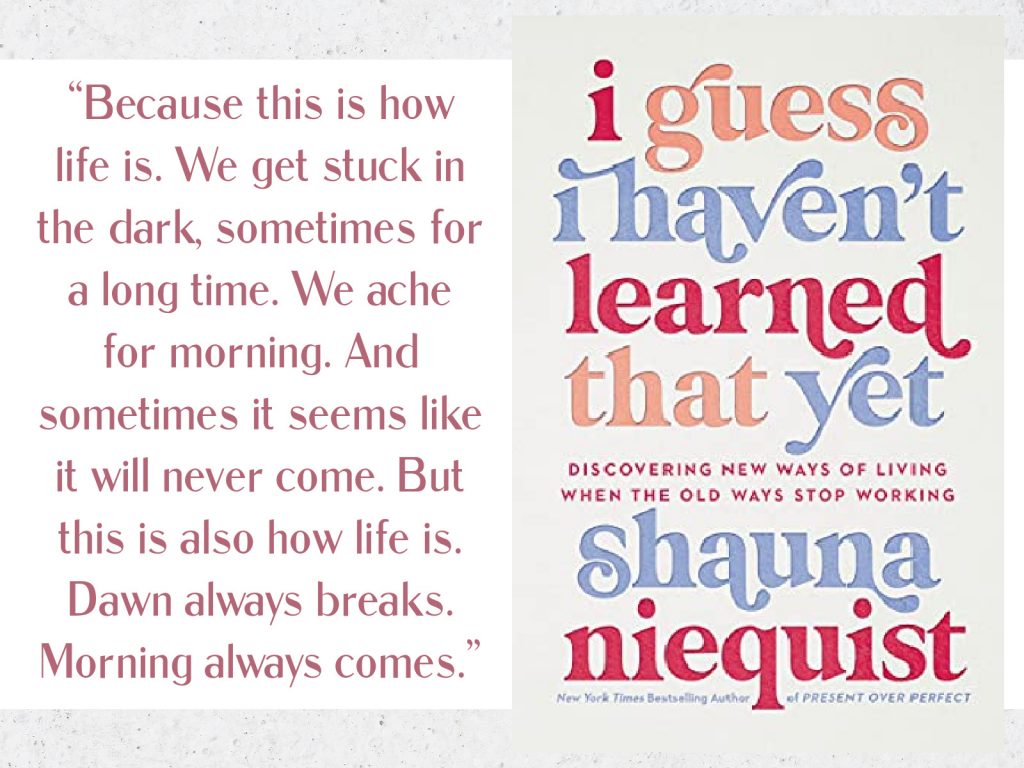
MIDDLE-GRADE FICTION
A Place to Hang the Moon, by Kate Albus: In 1940, Anna (9), Edmund (11), and William (12) become orphans when their only guardian, their grandmother, passes away. Like many London children, the siblings are evacuated to the countryside. But unlike most of the other evacuees, these three won’t be returning to the city after the War, and they hope to be placed with a family who will permanently adopt them once the wartime danger has passed. But as they are passed from one billet to the next, the siblings quickly learn that finding a forever family may not be possible in these days of food rations, suspicion, and heartache. The trio eventually find a friend in Nora, the town librarian who shares their love of stories as well as their struggle to fit in with the other villagers.
This book is feel-good middle grade fiction at its best. With plenty of Narnia vibes, cozy narration, and literary references galore, there is so much for both children AND adults to love about this novel. The setting and premise aren’t new ones, yet the story feels comfortable rather than stale. Of course there are difficult themes here: prejudice, abandonment, and wartime hardship, to name just a few. But the resilience, courage, and affection demonstrated by these three siblings, and the kindness they eventually experience, shine far brighter than the story’s hard, dark spots. The writing is superb and insightful: smart, funny, and speaking to children rather than at them; the book is truly a step above your standard middle grade fiction.
I listened to this one, and though the production is great, I have no doubt I would have liked it even more in print as I don’t generally love middle grade fiction on audio. I will definitely be revisiting this one as a read-aloud with the kids in a couple of years, and wouldn’t be surprised if a second reading bumps this up to a full five stars for me.
My Rating: 4.5 Stars (Rounded up to 5 Stars on Goodreads) // Book Format: Audiobook
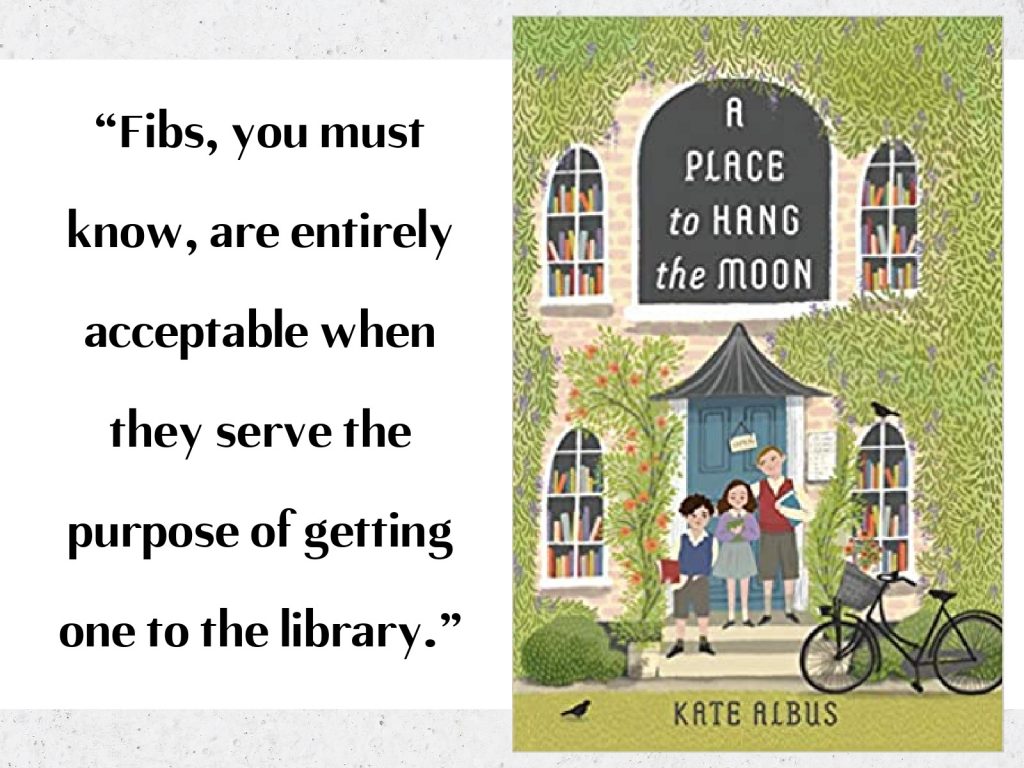
Tales of a Fourth Grade Nothing, by Judy Blume: I have such fond memories of my mom reading this series to our family when my brother and I were young, and again of reading them aloud to my students when I taught elementary school. This is a series I’ve been excited to introduce to Charleston, and because the book is about an older brother and his two-and-a-half-year-old sibling, now seemed like an ideal time to bring Peter and Fudge into our family.
The book is narrated by Peter, a fourth grader living in New York City with his parents and challenging toddler brother, “Fudge.” Life with Fudge is always an adventure, and Peter valiantly weathers Fudge’s tantrums and drama—even when it involves Peter’s school projects getting destroyed, or his having to “perform” at the dentist or the shoe store or a commercial filming as a role model for the recalcitrant Fudge. Peter’s straightforward and honest storytelling is painful but humorous, and oh-so-relatable for every older sibling or parent.
Our family chuckled through the stories in this book, but it read much differently through my parenting eyes. I empathized with Peter as well as his parents, who are doing the best that they can but also making MANY poor decisions (decisions I didn’t recognize as inappropriate as a younger reader). This was written in the 1970s and would be a very different book if it were written today: much has changed, from parenting practices to the level of independence and responsibility placed on children, to what is deemed appropriate childhood behavior. In some ways I’m glad to see how far we’ve come; in other ways, I was saddened to see what has been lost in this generation of parents who coddle and overprotect our children.
As enjoyable as this book is, the writing style annoyed me: the sentences are short and choppy which fits with the tone and narrator but not with my desire for a more dynamic reading experience. Charleston didn’t mind this at all, though, and as he is the intended ended audience for this middle grade book, I’ll own that it’s really just my own preferences and not truly a bookish flaw. I’m so happy that Charleston enjoyed this as much as I did at his age, and we are looking forward to reading more about Fudge and Peter in the future.
My Rating: 4 Stars // Charleston’s Rating: 4.25 Stars // Book Format: Print
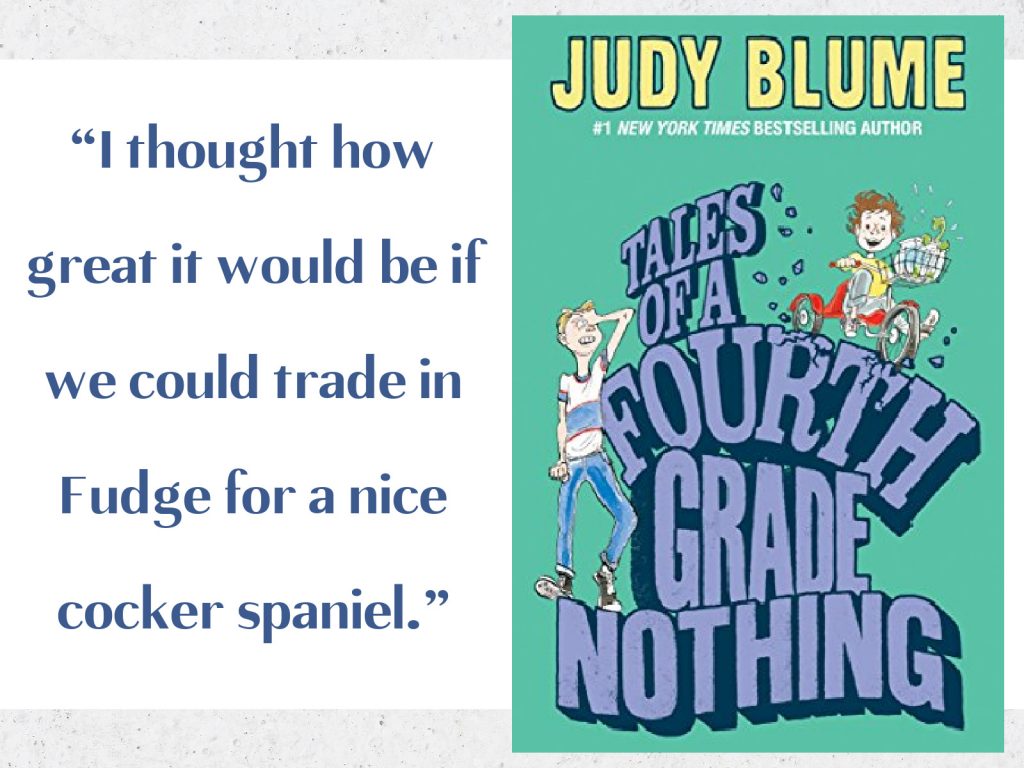
Nancy Drew: The Hidden Staircase, by Carolyn Keene: I was pursuing our library bookshelves this month and a wave of nostalgia came over me when I noticed a shelf of those iconic yellow hardcovers. As a child, I loved Nancy Drew, who served as one of my first forays into the mystery genre that is a favorite of mine to this day. I was a little nervous to revisit this series that holds such a special place in my heart, but the allure was too strong and I came home from the library toting The Hidden Staircase (a book I know I read as a child, though I couldn’t recall the details).
The story begins when Nancy’s friend Helen invites her to help solve the mystery of her aunts’ haunted old home. Nancy agrees, despite warnings from a mysterious visitor who threatens Nancy’s father and “suggests” she remain by his side. At the house, Nancy quickly assesses the situation and follows the house’s lead to identify the “ghost” and solve the mystery of who is wishing ill will upon Carson Drew and Nancy’s friends.
I have to say that my memory of this series (or at least this particular book) didn’t do justice to the quality of these classic stories. On reread I was impressed with the plot intricacies and complex vocabulary! There is little in the way of character development or deeper thematic elements, but I appreciated the straightforward nature of the story—so different from the issue-driven, angsty YA novels of today.
In doing a little research into the Nancy Drew series, I discovered that this book was initially published in 1930 but (along with all of the original titles) received a complete overhaul in 1959. I would love to get my hands on the 1930 version, but even this “updated” edition is now a classic and I loved the subtle fifties references. Sure, the characters fall into stereotypes and there is some dated language, but overall this really does hold up. Nancy is such a great protagonist: bright, helpful, kind, resourceful, courageous, and responsible. Is this realistic for an 18-year-old heroine? Not at all, but I love the healthy role model she can be to girls, even contemporary ones.
I don’t feel the need to reread this whole series just yet, but I was so happy to see that Nancy Drew does stand the test of time, and I will keep these books in my back pocket for whenever I’m in need of some fun comfort reading.
My Rating: 4 Stars // Book Format: Print

ADULT FICTION
Love & Saffron, by Kim Fay: In the fall of 1962, 27-year-old Joan Bergstrom (a young food writer living in Los Angeles) sends a fan letter and accompanying gift of saffron to Imogen Fortier, a woman thirty years her senior who writes a monthly magazine column from her home in the Pacific Northwest. Imogen replies to Joan’s note, and the two form a strong yet unlikely friendship, played out largely in letters that follow them through national crises and unexpected life changes. We join Joan and Imogen as they witness the Cuban missile crises and the Kennedy assassination; participate in social movements; and live through an exciting period for women like themselves who have not chosen conventional life paths.
Bolstered by this friendship that radiates mutual admiration and affection, Joan and Imogen tap into parts of themselves that had long remained buried beneath insecurity, failures of imagination, and societal expectations. And as Joan and Imogen bloom into their fullest, most vibrant and fulfilled selves, they (along with us, their readers) embark on cultural, culinary, and creative adventures beyond what either woman could ever have imagined.
Oh, I adored this book! I am always a sucker for a good epistolary story; throw in a cross-generational friendship, a creative food element, and an exciting historical backdrop, and I was utterly smitten. Though this would have very much been a “Kendra” novel at any time, it came at an especially fitting point in my reading life, following a series of good but heavy and plot-twisty books that left me craving something a little gentler and more straightforward. The comfort-level here is high; Joan and Imogen’s letters exude vibrant reflection, bittersweet undertones, delicate humor, and oodles of charm. The references to actors, novels, and songs from the 1960s add an especially fun touch that evoked nostalgia for an era I never experienced firsthand—a time that, for all its challenges, seems so much simpler and more straightforward than our world today.
Though I’m not a foodie, I do enjoy the occasional food writing, and the spices and flavors that fill Joan and Imogen’s letters had me salivating. I was particularly fascinated by the descriptions of the 1960s LA food scene, with its Mexican influence that was altogether foreign for Seattle-dwelling Imogen, who had never heard of garlic or tasted a tamale! How fascinating to reflect on a time not-so-long-ago when such flavors were considered exotic and access to ingredients was limited.
The novel’s only downside is the abrupt ending and too-short length, though I did appreciate that it could be enjoyed in a single sitting. Perfect for a cozy afternoon by the fire or, in my case, an enjoyable summer afternoon on the porch, cold beverage in hand.
(One final high point: I was warmed to read the author’s note explaining that much of the novel was inspired by real individuals, as well as Kim Fay’s own decades-long penpal relationship with a good friend!)
My Rating: 5 Stars // Book Format: Print

The Appeal, by Janice Hallett: At the outset, it all seems fairly straightforward: the Fairway Players theater troupe is embarking on its next community theater production, with all participants eager to return to the stage. When Poppy, the two-year-old granddaughter of the Players’ founding couple, is diagnosed with cancer, the members keep up with their busy rehearsal schedules while also rallying to raise money for Poppy’s treatment. Soon the fundraising has taken over their lives, but not all involved are convinced the treatment is appropriate or that the money is being well managed.
Conspiracy and double-crossing seems likely, but who can be trusted? Who among this unlikely group of friends and family is not as they seem? These are among the questions presented to two law students who are invited to examine the details of the case and form their conclusions.
This is one of the most creatively structured books I’ve read: taking the epistolary format to the next level, it is comprised entirely of emails and text transcripts, with a few newspaper headlines sprinkled in. Though this is technically a novel, it felt less like a reading experience and more like working my way through a puzzle—and I absolutely inhaled it! The pieces come together slowly, but clues are scattered throughout, with even the most obscure documents and missives holding answers to the ultimate mystery playing out.
This book won’t be for everyone; most of the negative reviews point to the implausibility of the emailing that takes place (why would these characters email rather than text or simply talk to one another in person?). This didn’t bother me, as it made for a a fascinating sociological study: the family/friendship/workplace dynamics unfold in some hilariously (and often painfully relatable) ways, and it was intriguing to see each character’s voice come through in their writing, then watch those same voices code switch for different interactions.
This would be a very fun buddy read—work together to solve the case, just as our two on-page sleuths do! And don’t attempt to read this in any format but print, as you will do quite a bit of flipping back and forth to solve the mysteries at hand. Also, do yourself a favor and bookmark the character list in the beginning pages, as you will refer back to it frequently. (There a lot of names and backstories, and this made it much easier to keep everything sorted in my mind.) You’ll also enjoy this more if you go in blindly: if possible, avoid the publisher’s description as it discloses far too much of the plot. If you read this, let me know if you correctly solved the mystery; I didn’t!
My Rating: 5 Stars // Book Format: Print

The No-Show, by Beth O’Leary: Sioban is an ambitious life coach whose confidence belies a tender heart and wounded spirit. Miranda is a spunky tree surgeon who likes to think of herself as “one of the guys.” And Jane is an insecure volunteer at a local charity shop who loves routine and is terrified of straying outside her comfort zone. These three women are strangers with ostensibly nothing in common, except for the fact that each of them has been stood up on Valentine’s Day. And we soon learn that each has been jilted by the same man. Joseph Carter is successful, charismatic, awkwardly charming and apparently great guy; but what kind of “good guy” would treat three significant others in this way? There is obviously much more going on with Joseph Carter—and with his three love interests—than meets the eye.
Romance is a “Venus fly trap genre” for me—one that often pulls me in with a strong premise but leaves me disappointed. Despite the “romance” label, I willingly picked this book up because reviews told me it did not contain any of my romance deal-breakers (open door love scenes, lack of substance, and an unnecessarily obvious plot). Those reviews did not lead me astray, as this book was refreshingly light on the steamy scenes and heavy on the meatier themes, and offered up several unexpected plot twists. The resulting story was an engaging read that thankfully did not leave me blushing OR rolling my eyes. I was intrigued by the characters, and though there are a lot of them and I struggled to keep their stories straight, I liked seeing the protagonists’ qualities play off of each other and noting the similarities and differences in their approach to love, friendship, and healing. I was especially interested in observing the way that Joseph Carter’s personality evolved over the course of the novel, and how different aspects of his character came out when he was with each separate woman. And the female friendships depicted in the novel were especially delightful; I enjoyed seeing women supporting and encouraging each other in various capacities in each subplot.
It’s tough to review this book without giving too much away. I don’t think it’s a spoiler to say that this story (stories) isn’t what it seems at first glance, and as I read I quickly picked up on the fact that there was quite a bit of authorial sleight of hand taking place. I’m not sure I liked the literary devices O’Leary chose to employ and wish she had been more straightforward about what was going on, as I felt quite tricked by aspects of the premise. I also found some of the trauma-related themes (particularly those related to workplace impropriety) pretty disturbing; and I grew more and more frustrated with the characters’ refusal to talk about what was going on (I’ve mentioned before that this is one of my biggest fictional pet peeves—when everything could be resolved with some good old fashioned honesty!).
With all of that said, I did find this to be a worthwhile read that offers a unique take on finding love after loss. We are given three romances (more, really, if you consider side-stories) in this book, and thought at times it was a bit much, they come together to paint an interesting picture of healthy relationships and genuine friendship, loyalty, and love. By the end I was hugging this book to my chest (through tears).
My Rating: 4 Stars // Book Format: Kindle & Print
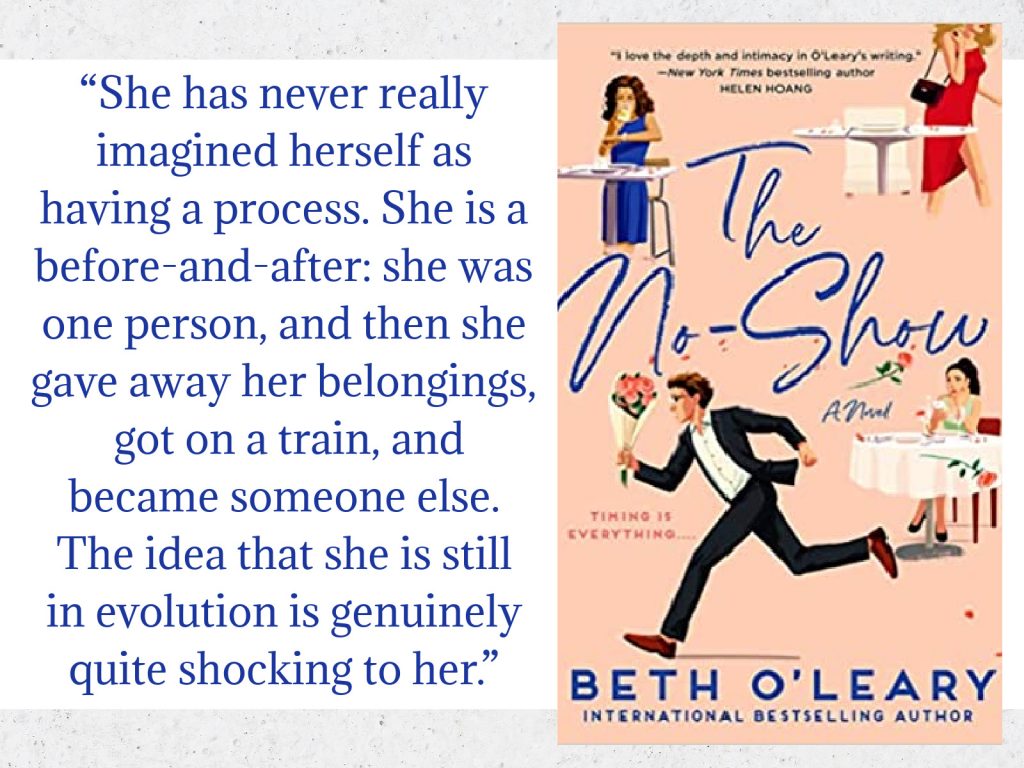
Cover Story, by Susan Rigetti: After a promising early academic career, aspiring author Lora Ricci is coming off of a disastrous year at NYU and feels grateful for her summer internships with ELLE magazine. While there she meets and is quickly entranced by Cat Wolff, an eccentric European socialite who is a contributing editor for the magazine. Cat takes the young writer under her wing and Lora is quickly swept into Cat’s glamorous lifestyle, going so far as to leave school to move in with the older woman to serve as her ghostwriter as she experience how “the other half lives” from their opulent suite at the Plaza Hotel. Soon, though, Lora discovers that life as Cat’s protégé isn’t all she hoped it would be and that Cat, herself, is not the woman she claims.
The story is told largely through Lora’s journals, and through documents interspersed throughout Lora’s story (news reports, FBI correspondence, receipts, emails, etc.) we learn that Cat is in fact a scam artist under FBI investigation, though Lora herself does not know this. As the novel unfolds, Lora’s suspicions of Cat increase. Nothing about these characters of this book is straightforward, as nobody can escape the beguilement of of Cat Wolff.
I had an idea of where this story was going from the beginning, and my suspicions were mostly confirmed, though there are some surprises towards the end that I did not see coming and that blew me away. Cover Story is a propulsive read that I could not put down. HOWEVER, I have to say that the writing style drove me a little batty: because the bulk of the story is told through journal entries, the narration is simplistic and juvenile—exactly how the journal of a college student would read, but not exactly original. Artistically this was the right choice, but as a reader I wanted more; Susan Rigetti is clearly a talented writer and I wish that her talent had extended into her prose. We are expected to suspend disbelief for a majority of this book; I would have been happy to suspend a tad more disbelief for the sake of a better crafted (if not stylistically realistic) reading experience.
Know going into it that you are reading this one for the plot (that ending!), as there is little to offer in terms of quality writing or character development. It’s not pure brain candy, though; amidst the totally bingeable story there are interesting themes of power imbalance, codependency, creative license, and the lies we are willing to accept to fit the narratives we want to believe.
Though this isn’t YA, it reads that way and for most of the novel I couldn’t shake the feeling that I’d already read a better-written version of this in Who Is Maud Dixon?. But this is not an exact read-alike, and if you enjoyed the premise of that novel (particularly its look at the publishing industry), you’ll likely love this.
I read this on Kindle and though I have not sampled the audiobook, I can imagine the numerous emails and transcribed text messages would make for a tedious listen.
My Rating: 3.75 Stars // Book Format: Kindle
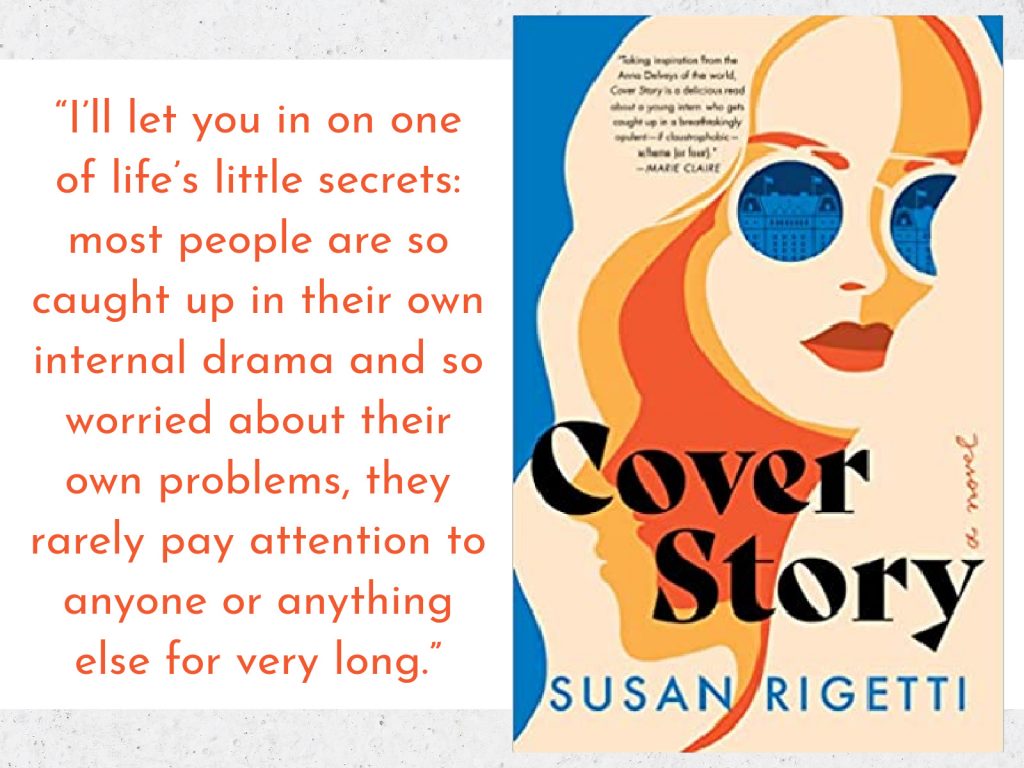
Have you read any of these books? If so, I’d love to hear your take! What have you been reading and loving (or hating!) this summer?
[…] Kendra’s blog review of Love & Saffron appears in this post. […]
I also listened to A Place to Hang the Moon this month and just loved it. Love and Saffron is a favorite so far this year too.
I have heard great things about A Place to Hang the Moon, though I never got a plot synopsis.
Here are my recent reviews if interested: https://elle-alice.blogspot.com/2022/06/june-book-reviews.html
Thanks for sharing this post in Carol’s blog collab. You have so many great books on this list. I was an early fan of Nancy Drew mysteries as were my daughters and now my granddaughter is loving them. They do stand the test of time.